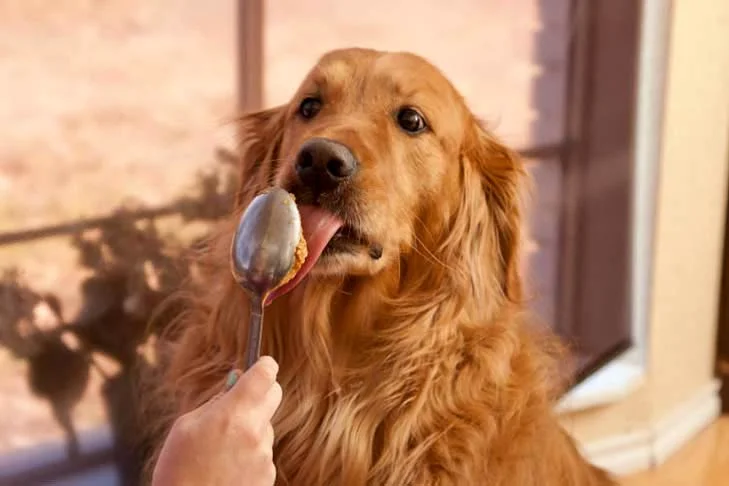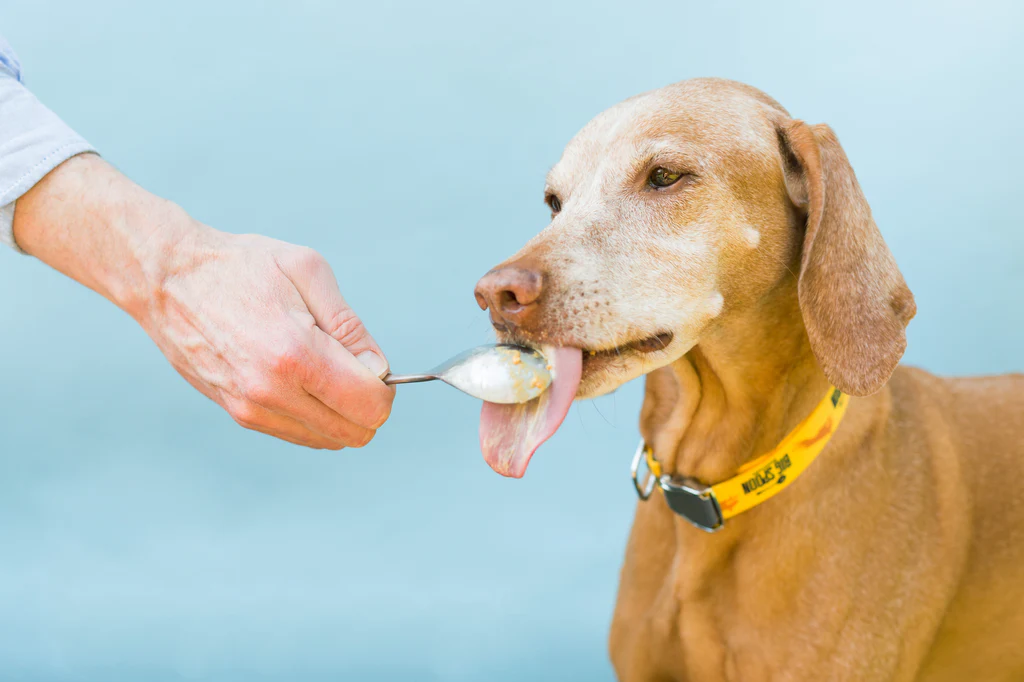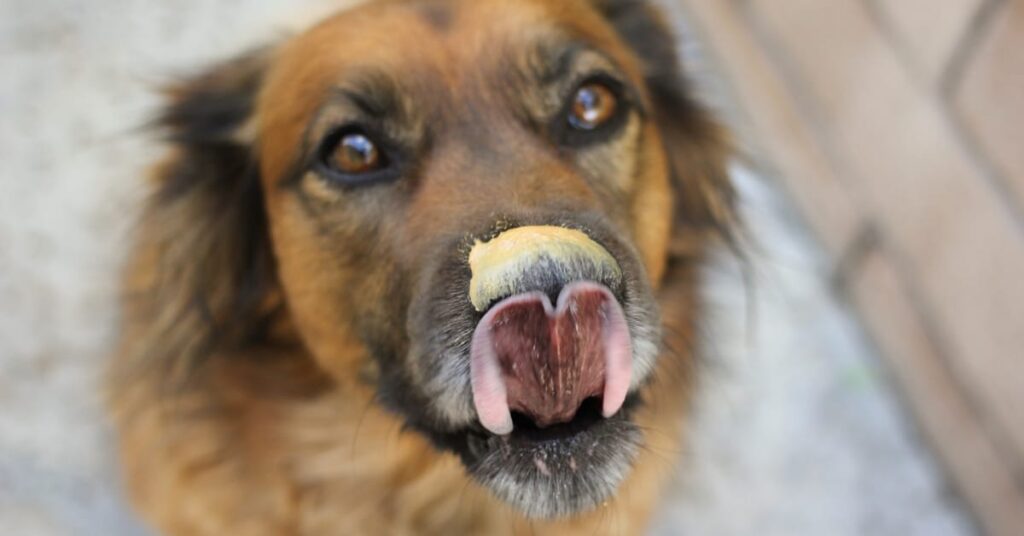You’ve seen it countless times — that wagging tail, those pleading eyes — the moment you crack open a jar of peanut butter. It’s as if your dog has developed a sixth sense for the nutty spread. Many pet owners use peanut butter as a treat, stuffing it in toys or offering a spoonful as a reward. But the question that often pops up is, “Is peanut butter good for dogs?”
Well, it’s not a simple yes or no. It depends on your dog, the type of peanut butter, and the quantity. Giving your dog peanut butter isn’t inherently bad, but like any treat, it should be given in moderation. So, let’s look into the nitty-gritty of dogs and peanut butter, and find out how much is too much.

Is Peanut Butter Good For Dogs?
Peanut butter can be a good treat for dogs in moderation, as it’s a source of protein, healthy fats, niacin, and vitamins B and E. However, there are a few important precautions to consider:
-
Xylitol: Make sure the peanut butter does not contain xylitol, a sugar substitute that is toxic to dogs. Even small amounts of xylitol can lead to hypoglycemia (low blood sugar), seizures, liver failure, or even death in dogs.
-
Low Fat and No Added Sugar: Choose natural peanut butter that doesn’t have added sugar or hydrogenated fats. These additives are not healthy for dogs and can lead to obesity and other health issues over time.
-
Moderation: Peanut butter is high in calories and fat, so it should only be given in small amounts as a treat. Too much can lead to weight gain and related health problems.
-
Allergies: While it’s rare, some dogs can be allergic to peanuts. Introduce peanut butter to your dog’s diet slowly and watch for any signs of an allergic reaction, such as itching, swelling, or difficulty breathing.
Peanut butter can be used as a treat, a way to disguise medications, or as a distraction during grooming or nail trimming.
How Much Peanut Butter Can Dogs Eat?
The amount of peanut butter a dog can safely eat depends on their size and overall diet. Here’s a breakdown to give you a general guideline:

Size and Calorie Intake:
- Small Dogs (under 10 pounds): Limit peanut butter to a half-teaspoon serving, one to two times per week. This small amount is enough for a treat without exceeding their daily calorie requirements.
- Medium Dogs (10-25 pounds): A teaspoon of peanut butter, one to two times per week, is a reasonable limit. Keep in mind their overall calorie intake and adjust accordingly.
- Large Dogs (25-75 pounds): One to two tablespoons of peanut butter, one to two times per week, might be okay for larger dogs. However, it’s crucial to monitor their weight and adjust based on their individual needs.
- Giant Dogs (over 75 pounds): Up to three tablespoons of peanut butter, one to two times per week, could be permissible for giant breeds. But again, prioritize their overall diet and consult your veterinarian for specific recommendations.
Important Considerations:
- Treats Should Not Exceed 10% of Daily Calories: Remember, peanut butter is a treat, and treats should ideally make up no more than 10% of your dog’s daily calorie intake.
- Consult Your Veterinarian: Every dog has different needs. Talk to your vet to determine the appropriate amount of peanut butter for your dog’s size, activity level, and any underlying health conditions.
- Calorie Content of Peanut Butter: Most peanut butter brands have around 180-200 calories per 2 tablespoons. Be mindful of this when calculating how much to give your dog.
Should Dogs Eat Creamy Peanut Butter or Crunchy Peanut Butter?

Whether dogs should eat creamy or crunchy peanut butter depends on a few factors, including their size, age, and overall health. Both creamy and crunchy peanut butter can be safe for dogs in moderation, provided they do not contain xylitol or unhealthy additives. Here are some considerations to help you decide which might be better for your dog:
Creamy Peanut Butter
- Easier to Swallow: Creamy peanut butter is smoother and may be easier for puppies, smaller dogs, or senior dogs with dental issues to consume.
- Less Choking Risk: Since it’s smooth, there’s a lower risk of choking, making it a safer option for using as a pill disguise or in toys and puzzles.
Crunchy Peanut Butter
- Texture and Dental Health: The bits of peanuts in crunchy peanut butter can provide a mild dental benefit, helping to remove some plaque from the teeth. However, this should not replace regular dental care practices.
- Chewing Satisfaction: Some dogs enjoy the texture and may find the crunchiness more satisfying or engaging to eat.
Frequently Asked Questions
Can dogs eat peanut butter?
Yes, dogs can enjoy peanut butter in moderation. It serves as a source of protein and healthy fats but overindulgence can lead to health issues like chronic pancreatitis, especially in smaller breeds.
How much peanut butter can I give my dog?
Treats, including peanut butter, should not exceed 10% of a dog’s daily caloric intake. For smaller breeds, a half teaspoon once or twice a week is sufficient. Larger breeds can have a full tablespoon roughly three times a week.
Is grocery store peanut butter safe for dogs?
Most grocery-store bought peanut butter is safe for dogs provided it doesn’t contain xylitol, a harmful additive. Always inspect the ingredient list before giving it to your pet.
Which peanut butter is the right choice for dogs?
Opt for peanut butter with minimal ingredients, preferably unsalted, and devoid of harmful additives like xylitol. Homemade or dog-specific peanut butter can be healthier options due to their lack of extra sugar and other added ingredients.
Does peanut butter pose any health risks to dogs?
While peanut butter offers beneficial nutrients, excessive consumption can lead to health problems in dogs. Key among these concerns is chronic pancreatitis, especially in smaller breeds, due to a high-fat content. Always offer peanut butter in moderation to prevent such issues.
Which brands of peanut butter contain xylitol?
Some brands with xylitol include Go Nuts, Co., Nuts ‘N More, and P28. Always check labels before feeding peanut butter to your dog.
How can I ensure my dog’s safety when feeding them peanut butter?
Monitor your dog’s peanut butter intake, opting for small, controlled portions to limit potential health risks. Always choose a peanut butter free of harmful additives like xylitol, and note the sodium and sugar content as well. It’s advisable to opt for a homemade or dog-specific variant whenever possible.

Hey there, I’m Janet Brooks, a dog-loving student from California. I’m all about helping pups in need, especially those without homes. Me and my awesome friends work together to give shelter and love to stray dogs. Oh, and I also write blogs about dogs to share helpful info.